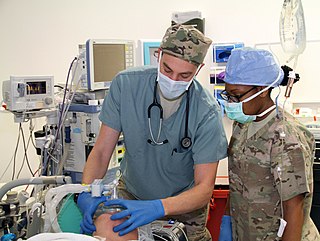Anesthesia or anaesthesia is a state of controlled, temporary loss of sensation or awareness that is induced for medical purposes. It may include some or all of analgesia, paralysis, amnesia, and unconsciousness. A patient under the effects of anesthetic drugs is referred to as being anesthetized.

Sevoflurane is a sweet-smelling, nonflammable, highly fluorinated methyl isopropyl ether used as an inhalational anaesthetic for induction and maintenance of general anesthesia. After desflurane, it is the volatile anesthetic with the fastest onset and offset.

Anesthesiology, anaesthesiology, anaesthesia or anaesthetics is the medical speciality concerned with the total perioperative care of patients before, during and after surgery. It encompasses anesthesia, intensive care medicine, critical emergency medicine, and pain medicine. A physician specialised in this field of medicine is called an anesthesiologist, anaesthesiologist or anaesthetist, depending on the country.

An anesthetic or anaesthetic is a drug used to induce anesthesia — in other words, to result in a temporary loss of sensation or awareness. They may be divided into two broad classes: general anesthetics, which result in a reversible loss of consciousness, and local anesthetics, which cause a reversible loss of sensation for a limited region of the body without necessarily affecting consciousness.
Awareness under anesthesia, also referred to as intraoperative awareness or accidental awareness during general anesthesia (AAGA), is a rare complication of general anesthesia when patients regain varying levels of consciousness during their surgical procedures. While it's possible to regain consciousness during surgery without any memory of it, the more clinically significant entity is awareness with explicit recall, where patients can remember the events related to their surgery. This article focuses on intraoperative awareness with explicit recall.

Desflurane is a highly fluorinated methyl ethyl ether used for maintenance of general anesthesia. Like halothane, enflurane, and isoflurane, it is a racemic mixture of (R) and (S) optical isomers (enantiomers). Together with sevoflurane, it is gradually replacing isoflurane for human use, except in economically undeveloped areas, where its high cost precludes its use. It has the most rapid onset and offset of the volatile anesthetic drugs used for general anesthesia due to its low solubility in blood.

An inhalational anesthetic is a chemical compound possessing general anesthetic properties that can be delivered via inhalation. They are administered through a face mask, laryngeal mask airway or tracheal tube connected to an anaesthetic vaporiser and an anaesthetic delivery system. Agents of significant contemporary clinical interest include volatile anaesthetic agents such as isoflurane, sevoflurane and desflurane, as well as certain anaesthetic gases such as nitrous oxide and xenon.
The American Society of Anesthesiologists (ASA) is an educational, research and scientific association of physicians organized to raise the standards of the medical practice of anesthesiology and to improve patient care.

Attempts at producing a state of general anesthesia can be traced throughout recorded history in the writings of the ancient Sumerians, Babylonians, Assyrians, Egyptians, Indians, and Chinese. During the Middle Ages, which correspond roughly to what is sometimes referred to as the Islamic Golden Age, scientists and other scholars made significant advances in science and medicine in the Muslim world and Eastern world.
Anesthesia carts are hospital devices used to store tools that are necessary for aid during procedures that require administration of anesthesia. Anesthesia refers to the use of drugs to subdue a patient's mind and prevent him or her from feeling any pain during a surgical operation. It is very important for anesthesia tools to be well organized and maintained so that patients receive proper anesthesia care. To ensure that patients remain unconscious and pain-free throughout the procedure, anesthesia supply carts can help to keep all the necessary anesthesia tools easily at hand.

The history of neuraxial anesthesia goes back to 1885.
Quintin Juan Gomez, MD was a Filipino pioneer anesthesiologist. He established the first formal training for anesthesiology in the Philippine General Hospital in 1949, earning him the title Father of Modern Anesthesia of the Philippines.

Aliflurane is a halocarbon drug which was investigated as an inhalational anesthetic but was never marketed.

Synthane is a halocarbon agent which was investigated as an inhalational anesthetic but was never marketed.

Halopropane is a halocarbon drug which was investigated as an inhalational anesthetic but was never marketed. Its clinical development was terminated due to a high incidence of cardiac arrhythmias in patients, similarly to the cases of teflurane and norflurane.
Miller's Anesthesia is an authoritative textbook on anesthesiology.

Norketamine, or N-desmethylketamine, is the major active metabolite of ketamine, which is formed mainly by CYP3A4. Similarly to ketamine, norketamine acts as a noncompetitive NMDA receptor antagonist, but is about 3–5 times less potent as an anesthetic in comparison. Also, similarly again to ketamine, norketamine binds to the μ- and κ-opioid receptors. Relative to ketamine, norketamine is much more potent as an antagonist of the α7-nicotinic acetylcholine receptor, and produces rapid antidepressant effects in animal models which have been reported to correlate with its activity at this receptor. However, norketamine is about 1/5th as potent as ketamine as an antidepressant in mice as per the forced swim test, and this seems also to be in accordance with its 3–5-fold reduced comparative potency in vivo as an NMDA receptor antagonist. Norketamine is metabolized into dehydronorketamine and hydroxynorketamine, which are far less or negligibly active as NMDA receptor antagonists in comparison, but retain activity as potent antagonists of the α7-nicotinic acetylcholine receptor.

Dehydronorketamine (DHNK), or 5,6-dehydronorketamine, is a minor metabolite of ketamine which is formed by dehydrogenation of its metabolite norketamine. Though originally considered to be inactive, DHNK has been found to act as a potent and selective negative allosteric modulator of the α7-nicotinic acetylcholine receptor (IC50 = 55 nM). For this reason, similarly to hydroxynorketamine (HNK), it has been hypothesized that DHNK may have the capacity to produce rapid antidepressant effects. However, unlike ketamine, norketamine, and HNK, DHNK has been found to be inactive in the forced swim test (FST) in mice at doses up to 50 mg/kg. DHNK is inactive at the α3β4-nicotinic acetylcholine receptor (IC50 > 100 μM) and is only very weakly active at the NMDA receptor (Ki = 38.95 μM for (S)-(+)-DHNK). It can be detected 7–10 days after a modest dose of ketamine, and because of this, is useful in drug detection assays.

Difelikefalin (INN), also known as D-Phe-D-Phe-D-Leu-D-Lys-[γ-(4-N-piperidinyl)amino carboxylic acid], is an analgesic opioid peptide acting as a peripherally specific, highly selective agonist of the κ-opioid receptor (KOR). It is under development by Cara Therapeutics as an intravenous agent for the treatment of postoperative pain. An oral formulation has also been developed. Due to its peripheral selectivity, difelikefalin lacks the central side effects like sedation, dysphoria, and hallucinations of previous KOR-acting analgesics such as pentazocine and phenazocine. In addition to use as an analgesic, difelikefalin is also being investigated for the treatment of pruritus (itching). Difelikefalin has completed phase II clinical trials for postoperative pain and has demonstrated significant and "robust" clinical efficacy, along with being safe and well tolerated. It has also completed a phase III clinical trial for uremic pruritus in hemodialysis patients.
Obstetric anesthesia or obstetric anesthesiology, also known as ob-gyn anesthesia or ob-gyn anesthesiology is a sub-specialty of anesthesiology that provides peripartum pain relief (analgesia) for labor and anesthesia for cesarean deliveries ('C-sections').













